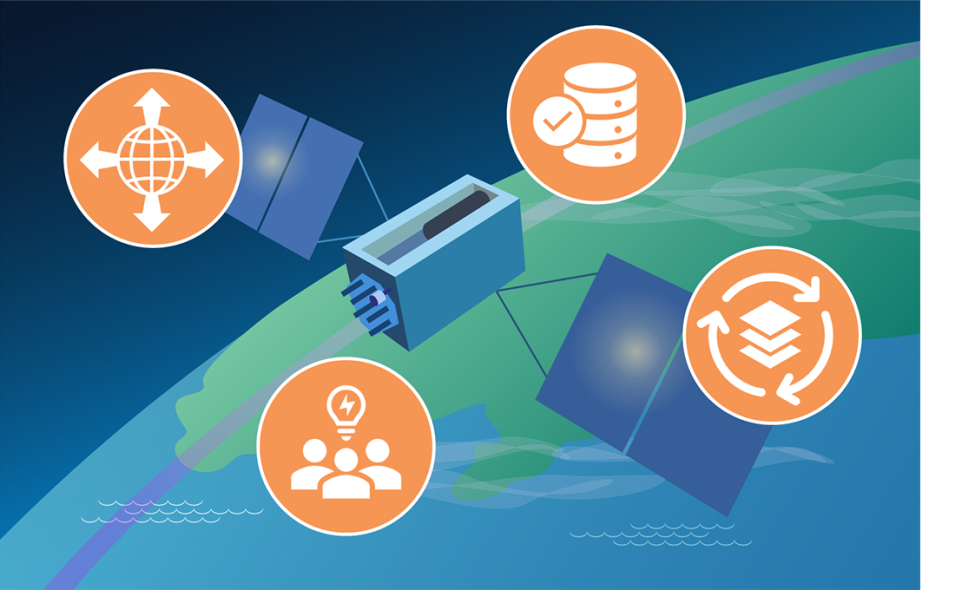The scientific community may use commercial datasets that are acquired by NASA for scientific purposes in adherence to vendor-specific terms and conditions. All data requests must be approved by CSDA by submitting the authorization request form. Once verified, the user will be provided with additional information on how to request and access data.
Current information about vendors, user licenses, and available data can be found in the vendor section below. As additional commercial satellite datasets are evaluated and acquired, those datasets also will be made available.
Vendors
Planet
Planet has successfully launched more than 500 satellites and currently operates approximately 200 Dove satellites and 21 SkySat satellites. Planet downlinks more than 300 million km2 of optical imagery daily.
Spire
Spire designs, builds, and operates a growing constellation of more than 120 3U CubeSat Low Earth Multi-Use Receiver (LEMUR) satellites equipped with multi-use radio frequency (RF) sensors that collect radio occultation and reflectometry data.
Maxar
The Maxar (formerly DigitalGlobe) constellation of high-resolution optical satellites offers unrivaled accuracy, agility, and collection capacity, imaging more of the world in the finest level of detail.
Teledyne Brown Engineering
Teledyne Brown Engineering operates the German Aerospace Center (DLR) Earth Sensing Imaging Spectrometer (DESIS), a pushbroom hyperspectral sensor installed on the Multi-User System for Earth Sensing (MUSES) platform on the International Space Station.
The Polar Geospatial Center
The Polar Geospatial Center (PGC) at the University of Minnesota produces high-resolution, digital elevation models (DEMs) of select areas of Earth’s land masses. The PGC is not a vendor, but is a CSDA partner in providing these data.
Airbus U.S.
Airbus U.S. provides a comprehensive catalog of synthetic aperture radar (SAR) Earth observation products from their TerraSAR-X, TanDEM-X, and PAZ X-band radar satellites. Evaluation of Airbus U.S. data is complete; only the data acquired during the evaluation are currently available.
BlackSky Inc.
The BlackSky satellite constellation provides imagery from the visible portion of the electromagnetic spectrum; their products include four image bands: red, green, blue, and panchromatic. Evaluation is complete; only the data acquired during the evaluation are currently available.
GHGSat Inc.
GHGSat specializes in the high-resolution remote sensing of greenhouse gases from space. Evaluation is complete; only the data acquired during the evaluation are currently available.
Vendor On-ramp and Evaluation
NASA’s ESD established a formal process for identifying commercial satellite vendors for on-ramp and evaluation. This process involves Request For Proposals (RFPs) followed by an independent NASA evaluation of selected commercial data products.
As necessary, NASA ESD will perform market research to assess the development of Earth science commercial data products and market growth across the industry. If warranted, RFPs will be issued to on-ramp additional vendors as the industry emerges with new candidates and capabilities.
Vendors meeting the minimum qualifications could submit an RFP so that NASA can evaluate the data to determine their suitability for advancing NASA’s science and application goals. All RFPs and contracts contain standardized scientific use EULAs to avoid confusion for users about how the data can be used. The CSDA Final Request for Proposal (RFP) was posted March 21, 2023.
Evaluation
Data products from selected vendors are evaluated by teams of principal investigators (PIs) selected by the ESD. Evaluation criteria include:
- Accessibility of data
- Completeness and accuracy of metadata
- User support services provided by the commercial entity
- Usefulness of submitted data for science and applications
The evaluation results are summarized and distributed to ESD senior management. NASA uses the summary evaluation report, individual PI reports, and other information to determine the suitability of data from each vendor for future procurement.
More details on the data evaluations are available on the Commercial Satellite Data Evaluation page. All data purchased during the evaluation phase are preserved for long-term use by the scientific community in accordance with the EULA.
Ongoing CSDA Program Activities
CSDA continually reaches out to the scientific community via science meetings, workshops, and conference presentations to increase interest in the program and learn how researchers are using the commercial data. Read publications by NASA-funded researchers to see how CSDA-acquired commercial Earth science data are being used.
Publications and Findings
NASA-acquired commercial data have a wide range of practical applications. Findings are statements showing how these data may be applied and include links to more information about these applications. View CSDA publications and findings.
Mailing List
Join the NASA CSDA Program mailing list to get our latest news in your inbox. To subscribe, email us at csda-program-news-join@lists.nasa.gov.
Frequently Asked Questions
NASA-acquired commercial satellite data distributed by CSDA have guidelines for their use. For general information about who is considered a NASA-funded or U.S. Government-funded researcher, commercial data available for download, the approval process for access to commercial data, and much more, please see the extensive CSDA list of Frequently Asked Questions (FAQs).
